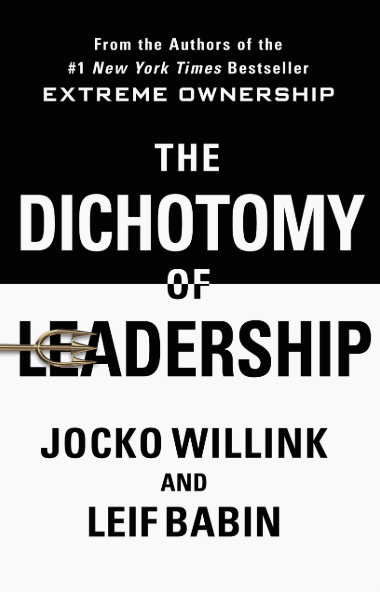Manager Reads - The Dichotomy of Leadership
22 Dec 2018Next up in the Manager Reads adventure is a book I’ve been looking forward to since reading Extreme Ownership. Pack some rations because this title is quite the mouthful: The Dichotomy of Leadership: Balancing the Challenges of Extreme Ownership to Lead and Win by Jocko Willink and Leif Babin.
Who recommended the book? Extreme Ownership has become a very popular book at Twitch. I’ve been eagerly waiting for this book and got reminded by several colleagues when it finally came out.

Judge the book by its cover, font, page quality? The cover of The Dichotomy of Leadership is very clever and ties into the central theme of the book: split down the middle with the top half in black and the bottom half in white. Balance between opposite extremes is the foundation of this book. This book isn’t a #1 New York Times Bestseller yet, so for now the cover has to settle for “From the Authors of the #1 New York Times Bestseller.”
Both Extreme Ownership and Dichotomy clock in around 300 pages but the kerning in Dichotomy is smidgen tighter (i.e. 33 lines of text per page in Dichotomy versus Extreme’s 32) so you’re getting more words per page. All in all, from its cover and page quality this is a solid book.
Thoughts on the book and the big take-aways? Extreme Ownership wrote that exceptional leaderships take absolute ownership of everything in their world. It seems some people took “extreme” a bit too literally which may have prompted the authors to write this sequel. In The Dichotomy of Leadership Jocko and Leif argue that leaders must constantly seek balance between opposite forces that pull in opposite directions. While there are countless dichotomies a leader must navigate, twelve are covered:
- The Ultimate Dichotomy - Leaders must care deeply about their team but be willing to put them at risk to accomplish the mission.
- Own It All, But Empower Others - Leaders must find the balance between micromanagement and a hands-off leadership style.
- Resolute, But Not Overbearing - Leaders cannot be too lenient but at the same time should not be inflexible on things that don’t matter much.
- When to Mentor, When to Fire - Leaders must mentor and lead underperformers, but if after that someone cannot perform at the required level they must be let go.
- Train Hard, But Train Smart - Training must be hard and push people out of their comfort zone but it can’t be so hard that it crushes the team and diminishes the opportunities for learning.
- Aggressive, Not Reckless - Leaders should lean forward and default to being aggressive (i.e. proactive) but should also ensure risks have been assessed and mitigated.
- Disciplined, Not Rigid - Leaders should adopt standard operating procedures but need to leave room for a team to adapt and adjust to unique situations.
- Hold People Accountable, But Don’t Hold Their Hands - Leaders must teach a team to hold themselves accountable by explaining the why of things because direct oversight over everything is not feasible.
- A Leader and a Follower - Leaders must lead but also need to be able to follow others, leaning on the expertise and ideas of other people.
- Plan, But Don’t Overplan - No plan is bad, and planning for everything is also bad. Each risk should be evaluated and contingencies should be put in place after assessing risk versus reward.
- Humble, Not Passive - Leaders must be humble to grow and entertain new ideas but must also be ready to stand firm when there is a risk to the team.
- Focused, Not Detached - Leaders must be attentive to details but can’t be so in the weeds that they lose track of the larger picture.
Per the Extreme Ownership format each dichotomy is covered with a real-life story of SEAL training or combat in Iraq, an overview of the principle, and an application to everyday businesses. The dichotomies covered are all reasonable scales for a leader to consider. Oscar Wilde preceded the SEALS by over half a century but likely put it best: “Everything in moderation, including moderation.”
Favorite quote from the book? “Humility has to be balanced by knowing when to make a stand.”
Elevator pitch for suggesting (or not suggesting) the book? The Dichotomy of Leadership presents a series of gradients that leaders should be cognizant of, but fundamentally the book didn’t move me at all compared to Extreme Ownership. Chapter after chapter I found myself thinking “Yes, this all makes sense” but I longed for a gem that would shift the way I viewed leadership. While it’s very helpful to have concise expressions of dichotomies I would only recommend this book if you feel there is some imbalance in your leadership style.
Notes in Evernote? Ready to dial your dichotomies into a harmonious and productive balance but want to use a cheat sheet? The word extreme shows up 18 times in my notes on 🐘.
Most of the world’s wisdom is written down in its best books. Manager Reads is a series covering books on management and leadership, focusing on books that can improve your own leadership with the wisdom of others. Enjoyed this post and want to see more? Check out more at Manager Reads.